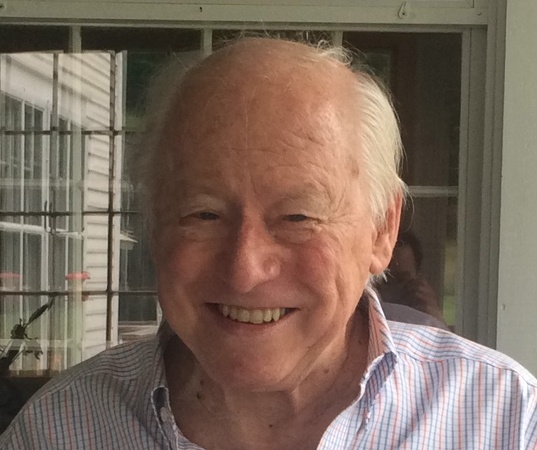
Dr. Hobson at his home in Vermont, 2016
It is with great sadness that we report the passing of Allan Hobson, M.D., a pioneering sleep researcher. Widely known for his work in dream theory and consciousness, Dr. Hobson wrote, co-wrote, or co-edited numerous books and hundreds of papers advancing our understanding of these high-profile and notoriously difficult objects of study. His capacity for this intense and focused study will be sorely missed.
Dr. Hobson grew up in Hartford, Connecticut and earned his medical degree from Harvard Medical School in 1959. After several years of internships, residency, and a fellowship in France, he returned to the United States in 1966 to Massachusetts, eventually becoming Director of the Laboratory of Neurophysiology at the Massachusetts Mental Health Center. His final appointment was as Professor of Psychiatry at Harvard Medical School. He won numerous awards over his long career, including in 1998 the Distinguished Scientist Award from the Sleep Research Society.
If you have any memories or pictures you would like to share on this memorial page, please submit them to [email protected].
Tributes from the Sleep Medicine Community

On October 14, 2021, Harvard Medical School lowered its flag to half-staff to honor Dr. Hobson’s life.
Carlos H. Schenck
Remembrance of J. Allan Hobson
Allan Hobson distinguished himself with investigations that spanned basic sleep research, clinical sleep research and dream research. He developed highly innovative constructs, such as AIMS (activation-input-modulation-synthesis) for dream generation, and he was a strong advocate for what he called the new “BrainMind Science”, with sleep as a cornerstone component, which he mentioned in a recent obituary for my late colleague Mark W. Mahowald (Schenck CH, Mahowald CM, Hobson JA. Sleep Medicine 2020;70:125-7). Allan was a highly-original and provocative thinker, who stimulated many students and investigators and promoted the careers of countless sleep and dream researchers, whose continued work help illuminate his legacy.
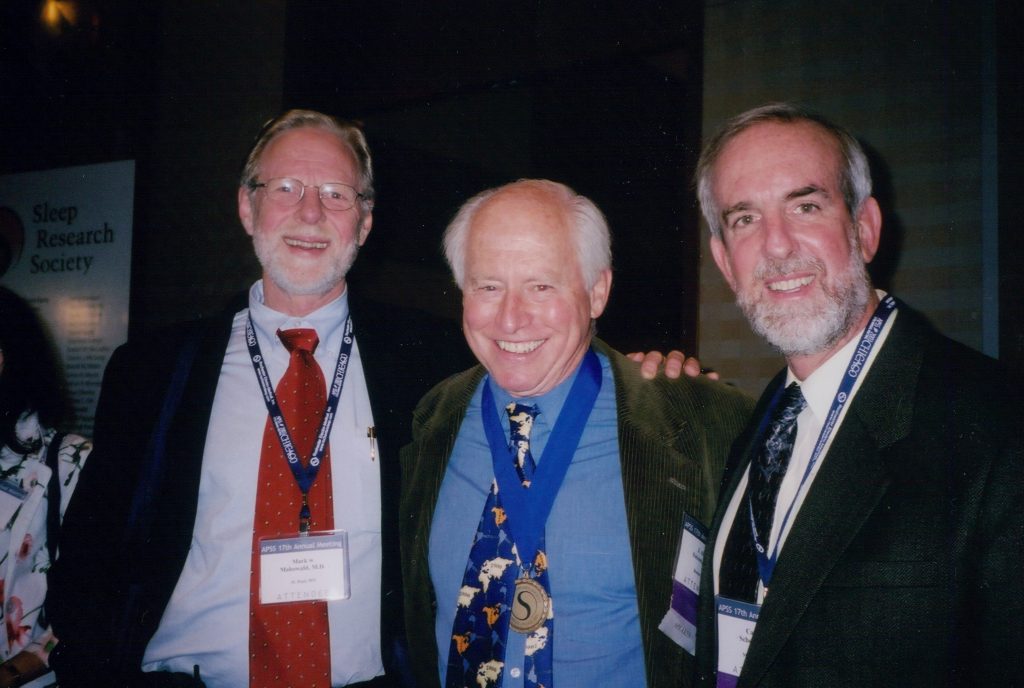
Mark Mahowald, Allan Hobson, Carlos Schenck (2003) REM Sleep Discovery 50 Year Anniversary Jubilee Chicago APSS meeting
Gary K. Zammit
I first became acquainted with J. Allan Hobson through his book entitled “Sleep,” which was published in 1989. Although, as a graduate student, I already had exposure to the work of many fine authors, Hobson’s book brought the science of sleep to life. He made it exciting, and he made it important. I was compelled to read his earlier work, “The Dreaming Brain,” published in 1988, and it helped to confirm that my career interest in sleep research was right for me. I later used both books in the undergraduate course I taught at Columbia University, and as expected, Dr. Hobson’s writing enthused whole classrooms over the years. I was privileged to meet Dr. Hobson after his retirement at an event held at the Loomis Chaffee School in Windsor, CT, where he once went to school. He welcomed me to his table, and he did what he did best. Teach. He still brought new concepts and ideas about sleep into full view. Dr. Hobson will long be remembered as a great contributor to our field.
Birgit Högl
The international community of sleep researchers has lost one of its first giants and pioneers. Professor Allan Hobson has provided so many innovative and significant inputs to the science of sleep and consciousness. During decades of prolific scientific work, Professor Hobson and his contributions have stimulated the interest and fascination of generations of students and researchers, who have then followed his legacy.
Ralph Lydic
Allan’s conceptual and empiric work on state-selective physiology make a lasting contribution to basic and clinical neuroscience. The photo below shows Allan Hobson and Rosalia Silvestri with friends after a symposium in Naples, Italy organized by Giancarlo Vesce.
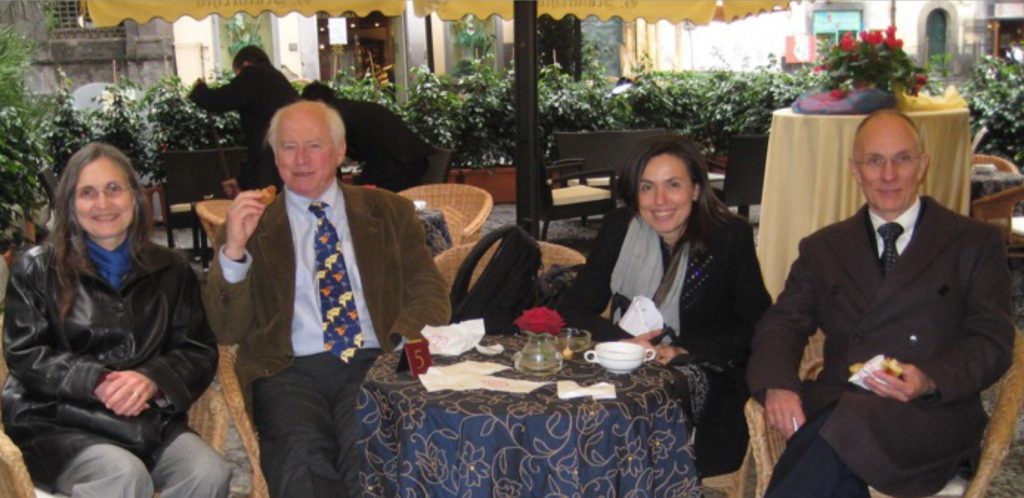
Luca Imeri
The first time I met Allan Hobson in person, it was back in the last century and I was young. When I write “young”, I mean VERY young: I was 27! I had just received my medical degree and started working in Mauro Mancia’s neurophysiology lab in Milan. At that time Allan Hobson was hosted in the ancient and magnificent villa the Rockefeller Foundation owns in Bellagio, on the shores of Lake Como. He was working on his book “Sleep”, which, when published shortly later (in 1989), impressed me for its crystal-clear and to-the-point science, as well as for its beauty. Which is something that, in my opinion, starts telling us something about Allan Hobson’s attention to that fundamental side of life (which, I was taught, tells the others who you are). One evening, while Allan Hobson was in Bellagio, Mancia invited him over to dinner in Milan, which is just 40 miles from Bellagio. Mancia was so generous to invite me to that dinner too. And this is something that, in my opinion, tells us something about the attitude of the great men and women of that generation with young fellows. We were less than two handful of people at the table, and I was (as I already told you, I know) very young and scared. Can you imagine? What do I remember mostly of Allan Hobson? His graciousness. Yes, his graciousness. To everybody and to me. It is possible that some colleagues won’t think of “graciousness” as the first word describing Allan Hobson, but I think that, if you are a true Professor everywhere in Academia (and at Harvard), it’s unlikely (impossible?) that you’ll be gracious to everybody. Almost thirty years later, when I last met Allan Hobson, I still met his contagious smile, his graciousness, his voracious curiosity about science, people, beauty and the world. In between I remember so many meetings, where Allan Hobson’s presentations were always so challenging and intellectually stimulating (but this “ça va sans dire”), and maybe a couple of dinners animated by paramount fights, for instance on the meaning (Hobson would not pass my use of the word) of dreams, between Allan Hobson and my Maestro.
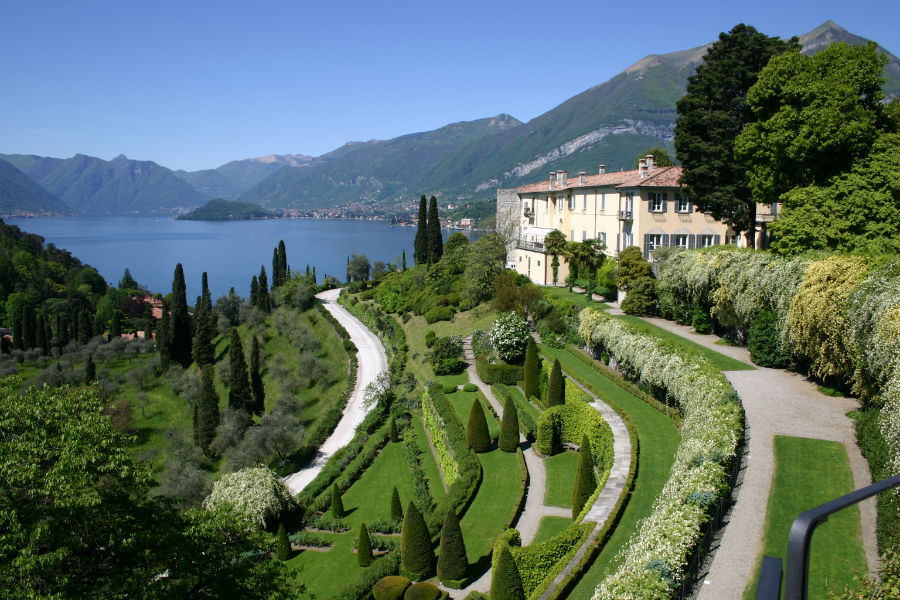
Karl Friston
I think Allan was preparing me gently for news of his death, with correspondence that – at times – had a sense of urgency and – at others – was full of morbid humour and compelling narratives about his dreams, family and failing body.
He was exactly the sort of person that made sense of ‘respect your elders’ – a true gentleman and intellectual aristocrat. Having said that, he had one of the youngest minds I have encountered, in terms of his creativity and curiosity. Over the past decade, he showed me (and academia) a new world of sleep and consciousness research – sometimes pushing from behind, sometimes sitting on my shoulder, but more often striding out ahead and beckoning impatiently. I am privileged to be a small part of his legacy – and share in his intellectual travels. I think he will be my last travelling companion. I will miss him.
Giancarlo Vesce
I first met Allan Hobson in Rimini, in year 2005. Allan was fond of Federico Fellini, which he had met in the nineties, as well of animals’ sleep that brought him there. He held the opening lecture of the annual meeting of the Association of Veterinary Anesthesia and Analgesia, the most important in this field. By explaining the correlation between sleep and anesthesia, he alerted those eminent scholars about the unique tool in their hands, warning them to watch closely the phenomenology of anesthesia in all orders of animals to contribute to science progress in the field of consciousness. Allan’s affable attitude and boundless culture made us friends right away. He loved teaching and spreading his studies. Few months later he visited the Federico II University where he lectured for five days in a row to MD and Vet anesthesiologists, as well to scholars, neurologists, psychologists, and students. At that time, he also held a University Conference to an audience of 400 professors on his recent book From Angels to Neurons. During the following 15 years professor Allan Hobson came back to Napoli on a yearly basis to teach at our Veterinary School, as well to chair and participate to meetings and cultural events on sleep, dreaming and anesthesia. In year 2012 he was co-opted as foreign member of the Accademia di Scienze Mediche e Chirugiche of the National Society of Letters, Science and Arts in Napoli. In year 2010 he was awarded the Laurea onoris causa in Medicine by the University of Ferrara, where he held a four-day course to neurologists on sleep and dreaming.
Allan Hobson’s death is a worldwide scientific loss and bereavement. I feel deeply indebted to Allan for his friendship, openness, tireless mentoring and for introducing me to many of his pupils among which Ralph Lydic and Helen Baghdoyan, both involved in a program of international cooperation with my University.
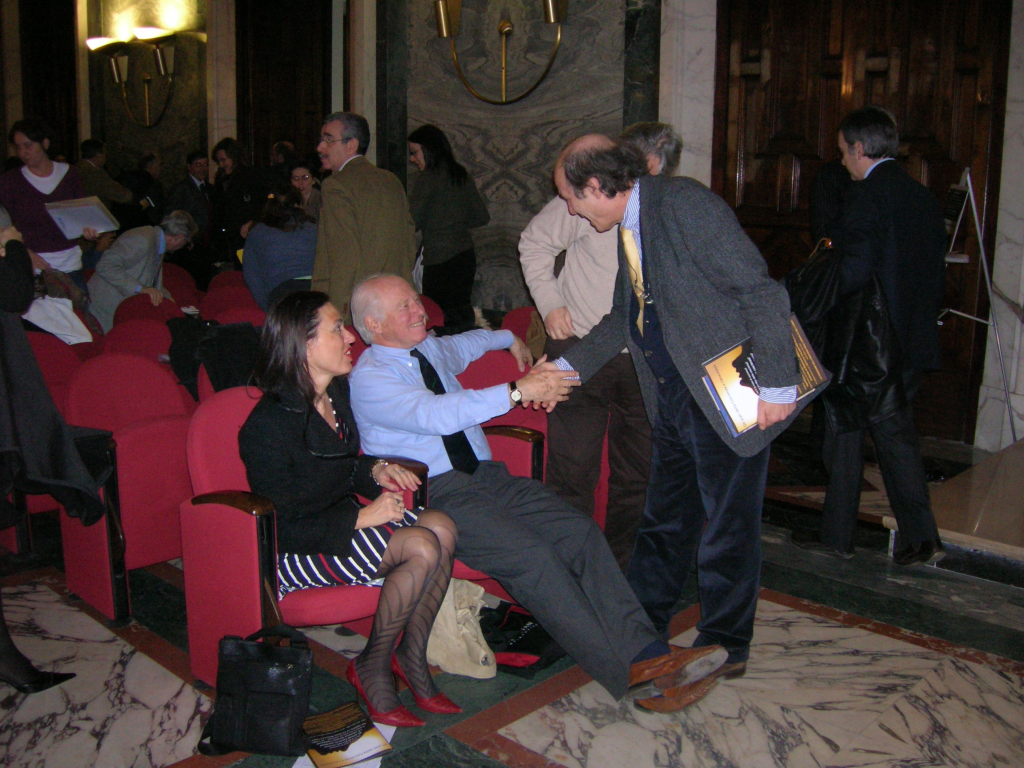
Naples, March 2006. Allan Hobson “At the Federico II Court”, shaking hands with rector Guido Trombetti, next to him his wife prof. Lia Silvestri.
Helene Sophrin Porte
Notes on Allan Hobson’s Dream Science
Brash, brilliant, intolerant of false complexity, Allan Hobson dared to take the simplest scientific measure of a dream: to enumerate its knowable features in terms of brain state – and thus of mind state – in REM sleep. Early on a morning in August, 1980, Allan recorded a dream from which he had just awakened. Here are some excerpts:
“I am skimming along a canal-river on a . . . vehicle that resembles a rowing shell but . . . there is no cockpit . . . I proceed rapidly to a destination in the city. The impossibility of the craft and my navigation is fleetingly apparent but any doubts can be driven away by minor and equally non-logical adjustments of posture. The sense of floating movement is pleasurable. I become aware of approaching a more built-up part of the city – i.e., the waterway narrows. . . . To hurry, my craft becomes . . . a kayak and I paddle-wheel it with my arms, increasing my speed appreciably in the now more narrow channel. Houses flash by and the cityscape is a pleasant meld of Marlborough Street, Boston and Grand Canal, Venice.
Suddenly – earlier than anticipated – my destination is in view. I know it by the distinctive appearance of an ornate building, which detaches itself from land and sails by me to the left. I marvel at the design – which is Venetian – Rococco – and the motion – which is linear swirling – i.e., the small building moves by and away from me in a slightly curving line but spins rapidly and then turns, abruptly right.
All of this action occurs in the instant before I must land. . . .”
Finding no commentary by Allan, I take this dream – its implacable acceleration; its artist’s eye – as Allan himself. And I take it, più o meno, on Allan’s terms. The dream’s neural wellsprings are at once random and intelligible. Its illogic is explicable, and its imagery decipherable, within its neural scaffolding. All without ado. Freud, of course, would unearth from the dream a disguised fulfillment of a forbidden sexual wish. I can hear Allan responding, in jest: “This dream neither needs nor embodies disguise. Use your imagination.” I can hear Allan responding further, in seriousness: “Where is the dream’s useful meaning? It is in its honest, raw, and manifest content.” I would add, and Allan would agree: In spots where a dream’s meaning is obscured, it is by accident of evolution. It is not by a censor’s design.
In 2014 I moved back to my home state of Vermont. Over the next years I enjoyed many good times with Allan in East Burke: exhilarating intellectual exchange, delicious meals prepared by loving caretakers, and laughter and fine wine. During those years I watched the progress of Allan’s physical disability. Ultimately he could not walk. Yet his mind – he would say his mind/brain – pressed forward eagerly, filled with fantastic images. Until the instant before he was gone.
Frederick Crews
I met Allan Hobson only twice, but both events were memorable for me, and Allan and I remained email penpals for life. In 1985 we were both attendees at a conference on psychoanalysis at St. Andrews University in Scotland. The event promised to be, among other things, a dramatic showdown between the two most prominent philosopher-critics of Freud, Adolf Grünbaum and Frank Cioffi, whose mutual antipathy was notorious. A heart attack, however, obliged Cioffi to stay home.
Cioffi’s absence from St. Andrews spared me the awkwardness of revealing to Grünbaum, my senior friend, that I preferred Cioffi’s views to his own. Briefly, Grünbaum felt that a strong case could be made against psychoanalytic theory only if its founder were credited with the utmost scientific earnestness and coherence. The case for validation or refutation could then be assessed in a high-minded way. But along with Cioffi, I already regarded Freud as having had more in common with Walter Mitty than with Newton or Copernicus. And, again with Cioffi but not Grünbaum, I believed that a pseudoscience could be recognized through its adherents’ deplorable behavior–namely, their unwillingness to be deterred or even embarrassed by negative results.
In conversing in that vein with Allan, I found that we were kindred spirits. Exact age mates, we had both started out in intellectual life as English majors and had been drawn to Freud by his mastery of persuasive rhetoric. Then we had reconsidered on empirical grounds and decided that we ought to warn others against being taken in by a stage magician’s tactics of misdirection. Of course our career paths had diverged from there. While I had remained a gadfly, Allan had gone on, remarkably, to become a physiologist of the brain, an innovative experimenter, and a joint proponent of the most compelling theory in his field.
Nevertheless, in Scotland I saw that Allan had also remained a humanist and a generalist. His interests lay all over the cultural map. He took delight in irony. And his conversation abounded in exuberance and good humor, without a trace of academic gamesmanship. He wanted to find out what others had to offer, and he had a way of drawing it forth with grace.
Before long, Allan invited me to venture from Berkeley to Cambridge in order to address his team of sleep researchers. He reassured me that my lack of expertise for making claims about dreams and dreaming wouldn’t be a problem. Just tell them what you think of Freud’s dream theory, he said. And so I did. In my talk, I maintained that the Freudian “mechanisms” allegedly turning a dreamer’s sexual thoughts into innocuous images actually served the opposite purpose of allowing each interpretation to arrive, casuistically, at a spurious sexual theme. As I recall, Allan didn’t explicitly agree or disagree, but he was pleased. I was serving his likely purpose of extinguishing any lingering Freudian tendencies among his young associates.
The aftermath is what I recall most fondly. An elegant dinner at Allan’s house was followed by a gabfest with the returning sleep lab people and several colleagues from the Harvard faculty. No punches were pulled, no one seemed to get tired of talking, and none went home until well after midnight. After decades of attending committee meetings and writing letters of recommendation, I was reminded by that intense session of why I had wanted to be an academic in the first place.
I missed seeing Allan after that (and I miss him now). But from time to time, as when I was preparing a book with chapters about Freud’s dream theory and his visionary speculations regarding the neuron, I of course sought Allan’s opinion. And you needn’t be told that it was given freely and frankly, and with an extra boost of encouragement as well. That’s just the way he always was.
Ursula Voss
So sad to hear of his passing and so fortunate to have known him. As a mentor, who introduced me to dream science at a time when I was searching for worthwhile topics off and east of classical mainstream psychology, he was the one who revived my scientific curiosity. I treasure the opportunity to have worked with him on the neurophysiology of lucid dreaming. As a companion, when hesitancy and doubt crept in – which sometimes happens when you start a research project off and east of mainstream – he intuitively kept guidance and assured it a pleasurable and meaningful journey. His enthusiasm, his wit, his creativity, his incredible gift for always accurate synthesis, guided by his scientific foresight, have fascinated me from the start. The longer I knew him, the more he impressed me. The scientific world has lost a giant. I lost a best friend.
Frank J. Sulloway
Allan was a scientist with great imagination, vision, and insight. He also emanated an intellectual joie de vivre that I always enjoyed during our conversations about our shared interests. I first met Allan after my book Freud, Biologist of the Mind (1979) was published, as he sought me out owing to our mutual agreement about the deficiencies of psychoanalytic theory—and in particular our agreement that Sigmund Freud had been crucially influenced by now-rejected nineteenth-century biological theories. Some of Freud’s erroneous biological assumptions exerted a considerable influence on his theory of dreaming, as Allan, along with Robert McCarley, showed in their classic 1977 paper. Other of these faulty assumptions were important in Freud’s whole conception of psychosexual development and the causes of neurosis, as I tried to show in my 1979 book.
Allan and I used to have fairly regular lunches together throughout the 1980s, during which we would discuss psychoanalytic theory and many other shared interests, including Allan’s ongoing research. It was always a delight to be able to talk with him at these and other times, and to benefit from his broad knowledge of psychiatry, neurology, and the scientific study of sleep and dreaming, as well as many other topics. I shall miss Allan greatly, and I cherish the good fortune that brought us together and allowed me to know him for so many years.
Jay Vogelsong
Allan Hobson was my friend and mentor. I first contacted him in 1992, after reading his book The Dreaming Brain, and shared with him my wife Janice’s and my experiences and experiments with lucid dreaming. He encouraged us to write our book on lucid dreaming, which we self-published in 2000. I also visited him at his farm in Vermont on a number of occasions starting in 2008, and we created a website for his Dreamstage Museum. He was a remarkably insightful character, and we will miss him.
